-
Engine5.0L V8
-
Power420 HP / 390 LB-FT
-
Transmission6-Speed Manual
-
DrivetrainRear-Wheel Drive
-
Curb Weight3,618 LBS
-
Seating2+2
-
Cargo13.4 CU-FT
-
MPG17 City / 26 HWY
Ford has been quietly blurring the line between muscle car and sports car since the 2010 Mustang debuted at the 2008 Los Angeles Auto Show. Lighter, smaller and nimbler than rivals like the Chevrolet Camaro and Dodge Challenger, the Mustang established itself early on as being just as happy on a road course as it was tackling the quarter mile.
With the introduction of the 5.0-liter, dual-overhead cam V8 for the 2011 year model, the Mustang found itself armed with the muscle necessary to blacken the eyes of its crosstown rivals after a painful period of trudging along with an antiquated 4.6-liter lump under the hood. Despite the additional brawn on hand, the pony has nonetheless been routinely bested in sales by the larger Camaro.
In an attempt to pull past its big-boned rivals, Ford has opted to continue its strategy of aggressive model improvements, and buyers who put their cash down on a 2013 Mustang can look forward to a new suite of technology, visual improvements, more power and available options aimed at making it an even more capable track machine. The tricks have turned one of the best performance buys on the market into an even more tempting option for buyers who want more than just a boulevard cruiser.
Designers have lent the 2013 Mustang GT a new nose, complete with a redesigned front fascia. A larger, more aggressive grille gives the face plenty of menace, framed with standard HID headlamps in both GT and V6 trims. Two LED accent strips give the Mustang a bit of a scowl with the lights on, and GT models now boast standard LED fog lights mounted in the grille. While base models also feature a new splitter set down low, our tester came lathered up with all of the niceties associated with the California Special package, including a larger jutting lip.
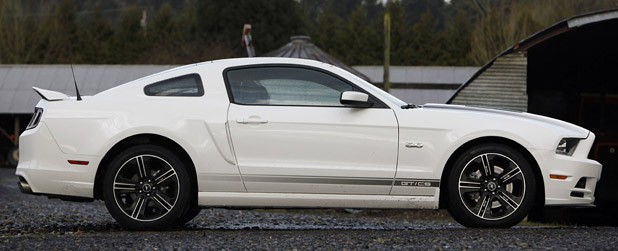
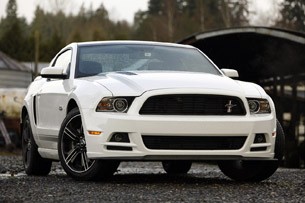
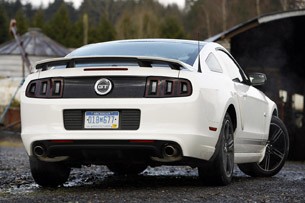
We need to take a moment to be honest with you. There are few things on this planet that make us quite as happy as functional hood vents. For 2013, designers have given the Mustang GT dual heat extractors set to the side of the coupe's curved hood. Watching waves of hot air push through the vents after a particularly athletic stretch of road is guaranteed to deliver gleeful grins from driver and passenger alike.
Move to the Mustang's side, and it's immediately clear Ford has expunged the specter of black plastic that cursed the 2012 model. Painted rocker panels are now standard equipment on both GT and V6 models, helping this heathen to look less at home snugged in the rental lots of the world. A range of new wheel options have also cropped up for the new model year and Ford says buyers now have 12 designs to choose from. That's the largest number in the history of the model, spanning from standard 17-inch rollers to the flashier 19-inch wheels found on our tester.Buyers now have 12 wheel designs to choose from, the largest number in the history of the model.
Ford has lifted a page from the Land Rover Range Rover Evoque playbook with a clever addition to the side-view mirrors. At night, unlocking the doors with the key fob results in an LED projection of a running horse on the ground below the mirrors. While that kind of trick may turn campy in a few more years, right now it's cool as hell.
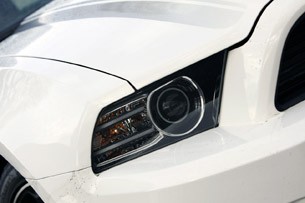
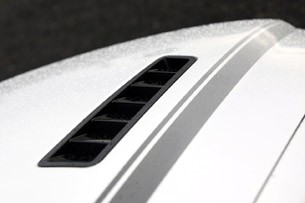

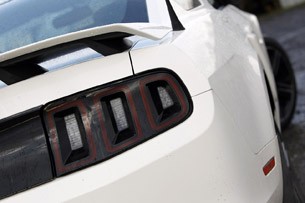
Around back, the 2012 Mustang wears a new black panel that ties together both taillamp arrays. As before, the lights use the same sequential turning-indicator design, but the new fixtures cleverly hide the reverse light with in the center brake cell. Kick it into Reverse, and the center section immediately switches from red to white with the help of some LED trickery. As a result, the taillamps look less cluttered and more cohesive than before. The new rear valance has also been body-color matched for a more cohesive appearance.
Jump indoors and expect to be met with a familiar-looking cabin. The handsome leather-wrapped, contrasting-stitched steering wheel is now standard on all models, which helps to class up the interior significantly. The sharp dash applique and expansive high-resolution LCD display are all present and accounted for as well, though owners may now option their Mustang with the same Recaro seats found in the Boss 302. At $1,595, the thrones are plenty pricey, but they add the kind of support necessary for real track-day abuse with the added benefit of factory side airbag protection.Owners may now option their Mustang with the same Recaro seats found in the Boss 302.
The biggest change to the cabin is nestled between the speedometer and the tachometer in the gauge cluster. Ford now offers buyers the ability to opt for a new 4.2-inch LCD screen controlled by a five-way switch on the steering wheel. The screen handles all of the usual information we expect to see in an information display, including trip mileage, fuel economy and various systems settings, but also throws in a few toys for drivers who are serious about their on-track performance, including the new Track Apps system. Drivers can make use of an on-board accelerometer to keep track of G forces pulled in every direction, track acceleration times from 0-30, 0-60 and 0-100 mph as well as eighth-mile and quarter-mile times using a virtual interpretation of the same Christmas tree found at your favorite drag strip. Check out the Short Cut below to see a few other Track App options.
In addition to the Track Apps, the 2013 Ford Mustang GT offers drivers a more comprehensive view of what's going on under the hood. The LCD can be configured to keep an eye on necessities like air-fuel ratio, cylinder head temperature and oil temperature – all handy for banging around your favorite road course. What's more, users can customize the amount of steering assist served up by selecting from three modes with the vehicle settings menu.
Then there's the new sound system. Buyers may skip the base stereo by stepping up to GT Premium trim. Doing so swaps the components for those of either the Shaker sound system with eight speakers and six channels of audio, or the mighty Shaker Pro system found in our tester. With nine speakers crammed into the confines of the cabin, including two tweeters aimed directly at passengers to replicate the concert experience, the system is so loud that Ford had to redesign the interior body panels to withstand the abuse of the stereo's highs and lows. In fact, Ford says the Shaker systems can produce deep bass just beyond the frame of human hearing. It's the kind of low you can feel sliding down your rib bones. Crank Queens of the Stone Age to inhumane levels and you'll find yourself with Josh Homme's tongue writhing its way down your ear canal. The tiny bones of your inner ear know they've never felt this way before, but they like it. It's equal parts sexy and amazing.Users can customize the amount of steering assist served up by selecting from three modes in the vehicle settings menu.
The 2013 Ford Mustang GT continues to be available with Microsoft SYNC, though the sports car has managed to evade a disastrous application of MyFord Touch. In the Mustang, SYNC is a breeze to use, making choosing your favorite album, artist or song as simple as pressing a button and saying a title. If only this level of simplicity could be translated to the company's more complex user interfaces.
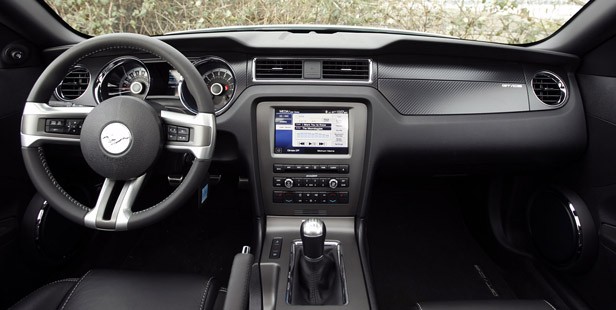
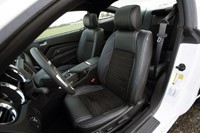
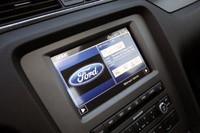
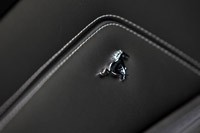
Ford hasn't simply left well enough alone under the hood, either. With 420 horsepower on tap, the 5.0-liter V8 dishes out just eight additional horsepower over the 2012 model. While that certainly isn't a huge number, every little horse helps in the muscle car wars. Buyers may choose from either a six-speed manual transmission or a six-speed automatic. The slusher is now available with SelectShift, which gives the driver the ability to choose and hold a gear as long as they see fit. Unlike other similar systems, Ford will let you bang on the rev limiter all day long if you so desire.
The Mustang is now within whiffing distance of the 426 horsepower available in the 6.2-liter Chevrolet Camaro SS while toting around significantly less weight. The Mustang tips the scales at a relatively light 3,618 pounds compared to the 3,849 pounds weighing down the Camaro.Ford will let you bang on the rev limiter all day long if you so desire.
That weight comes to bear on every measurable aspect of performance, from acceleration and braking to lateral grip. Despite its slimmer waistline, the Mustang still maintains some of its big muscle-car swagger on the road. Really dig for the throttle and you're rewarded with a nose that kicks skyward in a powerful display of weight transfer. Likewise, the car has a tendency to float its way over uncertain pavement without leaving a trail of shaken kidneys discarded on the road behind it. Given those traits, we half expected the Mustang to turn sloppy once we got frisky with the steering wheel. But in the rain-soaked mountains and hills outside of Portland, Oregon, that simply wasn't the case.
There was a time when the Mustang dreaded changes in road direction like honest Americans loathe tax time, but the 2013 GT simply comes into its own the harder you drive. The suspension firms up nicely, resulting in a confident, planted feel that encourages further plunges of the throttle. From the first apex, it's clear there's serious speed to be wrung from this chassis. Of course, the vehicle never lets you forget there's a 420-horsepower heathen engine kicking just in front of your heels. The V8 has a rumbling idle and barking exhaust note that harkens back to the old-school eights of yore. Listening to the grumble and howl of the 5.0-liter is perhaps the only suitable argument for turning down the Shaker system. Get overzealous with your right foot at any time, and the power simply piles on, sending the rear wheels kicking and the tail end out.The 2013 GT simply comes into its own the harder you drive.
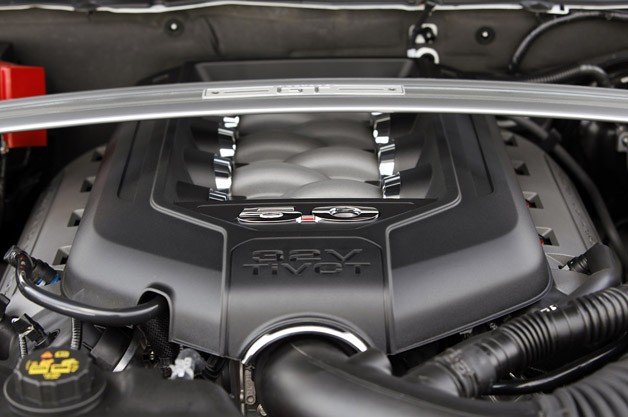
Be smart about when you pour on the power, don't overcook your line and the 2013 Mustang GT will be a willing dance partner any day of the week. There is no dramatic oversteer or clumsy understeer plowing. Just more poise than should be possible from a live-axle, well-tuned or otherwise. Those who pine for an independent rear suspension may politely shut their pie holes.
Ford has also nailed the traction control system on the 2013 Mustang GT. The nannies will let the driver have just enough fun to widen eyes and pucker seats, but do a tidy job of reining in the chaos once things go squirrely. We love it, and honestly, it's the only way drivers unfamiliar with mountains of torque will be able to keep themselves from turning the car into modern art as sculpted by inertia, mass and an unfortunately placed telephone pole.The only genuine complaint we could drum up was in the car's brakes.
After a solid three hours of caning the Mustang GT over hill and dale in the Pacific Northwest, the only genuine complaint we could drum up was in the car's brakes. The system simply doesn't have the crisp bite we expect from a legitimate sports car, and while we could easily push through the soft pedal to some real stopping prowess, we would certainly want a more confidence-inspiring system in a sports coupe we meant to take to the track.
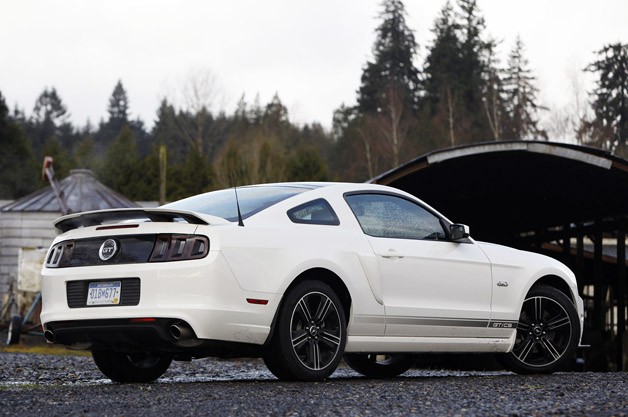
Fortunately, Ford has a solution for us in the newly available Track Package. Built on the 2012 Brembo brake package, the kit combines 14-inch ventilated front discs mashed by four-piston calipers and performance pads with a more aggressive cooling system and rear axle ratio. Buyers who opt for the track package will enjoy a larger radiator than before, complete with extra capacity in the oil cooler and the same 3.73 rear axle found in the Boss 302. The kit will set you back $2,495, which seems like a small price to pay given the hardware on hand. Try compiling those goodies on the aftermarket, and you can look forward to forking over considerably more coin. We do wish the more supportive Recaro seats were part of the Track Package, however.
Buyers who skip the track goodies, SYNC tech integration and ear-vaporizing Shaker sound systems for the base model can look for an MSRP of $31,095. That slips just under the entry price for the Chevrolet Camaro 1SS at $32,280, excluding destination charges for both. But comparing those two ponies is a purely academic exercise. While the two coupes share a long and storied competitive past, the truth is that today, the Mustang and the Camaro have diverged from each other in a big way.The truth is that today, the Mustang and the Camaro have diverged from each other in a big way.
Ford seems to realize that many buyers tire quickly of big flash and straight-line punch, and has created a range that can just as easily be compared to a genuine sports car like the $60,100 BMW M3 Coupe with its 414-horsepower 4.0-liter V8. We can hear your scoffs echoing across the great expanses of the internet already, but the truth is the 2013 Mustang needs only a slightly sharper suspension and a more well-sorted brake system to be transformed from an already impressive machine into a purebred sports car. Then again, that's what the Boss 302 is for.










Sign in to post
Please sign in to leave a comment.
Continue